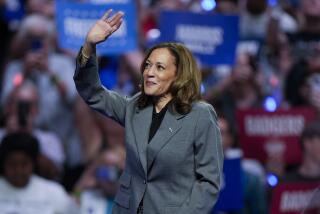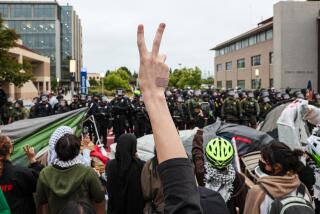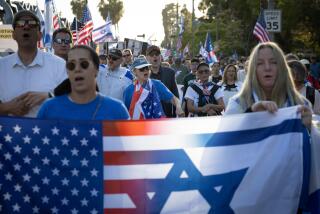Groups Give U.S. Muslims a New Voice
Even before the second plane crashed on Sept. 11, Ibrahim Hooper of the Washington-based Council on American-Islamic Relations was typing out a condemnation of terrorism. By noon, it was ricocheting off faxes and computer screens worldwide.
In the Washington office of the Muslim Public Affairs Council, Maher Hathout and Salam Al-Marayati offered the “Muslim point of view” on the Arab television network Al Jazeera, CNN and Fox News.
A few blocks away, executives at the American Muslim Council called an ally, a GOP stalwart with presidential access. A lot of innocent, hard-working American Muslims could get hurt because of this incident, they told their intermediary. We need the president to say something.
Two days later, during a televised conference call with New York Mayor Rudolph W. Giuliani and Gov. George Pataki, President Bush did just that: “We must be mindful that as we seek to win the war, that we treat Arab Americans and Muslims with the respect they deserve,” he said.
Those moments illustrated how a bevy of young American Muslim organizations have suddenly risen in visibility. A decade ago many of those groups did not exist. Since Sept. 11 they have mounted a coordinated campaign to contain an anti-Muslim backlash and weigh in on U.S. decisions affecting the Muslim world. They are also telling a fearful and suspicious American public who Muslims are, what they believe--and how they distinguish themselves from madmen with box cutters.
Their evolution has been shaped by historic obstacles and the diasporic character of their constituency. About a third of U.S. Muslims, whose numbers are variously estimated at 1 million to 7 million, are African Americans. Many of the rest are recent immigrants from nations as varied as Lebanon, Nigeria, Malaysia and Mauritania. There are Sunni Muslims and Shiite Muslims. There are Sufi mystics, nonaffiliated Muslims and secular Muslims--who drink, eat bacon and attend mosque only on holidays.
Many American Muslims emigrated from some of the world’s most repressive nations. As a result, they have traditionally been reluctant to vote, run for office or speak out in their own defense. U.S. Muslim groups have recently faced those challenges by avoiding fractious doctrinal disputes and focusing on political education and advocacy.
Groups Sprang Into Action Sept. 11
Following the lead of secular civil rights groups such as the National Assn. for the Advancement of Colored People and the Anti-Defamation League, U.S. Muslim groups are more likely to fax a news release than issue a fatwa (a religious edict). The new breed of U.S. Muslim groups that surged into action Sept. 11 is ecumenical and media-savvy. They endorse political candidates and lobby Congress on the treatment of Muslims here and abroad. Verified membership numbers are hard to come by, but each of the two largest groups--the Islamic Society of North America and the Muslim American Society--have drawn more than 25,000 people to their annual conferences.
“It’s really a defining moment for our community,” said Aly Abuzaakouk, president of the American Muslim Council, which in recent weeks has held nonstop meetings with officials from Congress, the State Department, the Department of Energy and other agencies.
In a recent article in the Jerusalem Report, David Harris of the American Jewish Council wrote, “the Arab and Muslim populations are growing, mainly through immigration, along with their political savvy and self-confidence. Political candidates come to their organizations’ meetings; the media seek their communal views.”
From among about 20 national Muslim organizations, four groups have taken the lead:
* In the style of African American civil rights organizations, the American Muslim Council lobbied for symbolic “firsts”: The first Muslim prayer during a congressional session. The first Muslim U.S. Army chaplain. The first Muslim holy day celebration at the White House. The first U.S. stamp to commemorate the end of Ramadan, the Muslim holy month of fasting.
* The American Muslim Alliance, led by UC Berkeley ethnic studies professor Agha Saeed, is focused more narrowly on cultivating U.S. Muslim political candidates and registering voters. Saeed envisioned what he calls “a demographic strategy for Muslims.” By 1996, 400 Muslim candidates--many of them trained by the alliance--ran for everything from U.S. senator to school board. Ninety-two Muslims were elected.
That same year, Republican presidential candidate Bob Dole came looking for an American Muslim voting bloc. It was a mixed victory--Dole refused to meet publicly with Muslim leaders, so the alliance turned him down. The aborted endorsement of Dole made U.S. Muslims realize how important--and how poor--their public image was.
* The Council on American-Islamic Relations started sending out press kits with vocabulary lists and usage guides. (Examples: Allah means God, not “a god.” jihad means struggle, not “holy war.” “Moslems” prefer to be called “Muslims.”) With 12 regional offices, the council’s main strategy is to use public relations campaigns to combat anti-Muslim discrimination in Hollywood and in the workplace.
The council’s first major response came after the bombing of the Alfred P. Murrah Federal Building in Oklahoma City in 1995. In the time it took to discredit false reports of “Middle Eastern suspects,” there were a spate of hate crimes, including an attack on a pregnant Middle Eastern woman. And an innocent Jordanian American was arrested, named in news reports and photographed in handcuffs.
“We actually flew [Executive Director] Nihad Awad [from Washington] to the site to coordinate the Muslim response there and meet with the media,” said council co-founder Hooper. Such a direct approach was unprecedented for the Muslim community, Hooper said. A photograph of that scene shows Awad standing alone at the center of a thick moat of reporters.
“Since then we developed the idea of a crisis team,” Hooper said.
A Place to Seek Redress
The council also began publishing annual reports on anti-Muslim incidents--spurring law enforcement agencies to be more vigilant in their protection of Muslims. In the same way African Americans have historically called upon the NAACP, the council has become one of the first places many Muslims turn when they believe their rights have been violated. Since the terrorist attacks the group has recorded more than 1,000 reported anti-Muslim incidents.
* The Los Angeles-based Muslim Public Affairs Council combines public relations with lobbying, Muslim advocacy and interfaith efforts. The group often takes unconventional stands, such as when it denounced an Iranian cleric’s death edict against novelist Salman Rushdie after he satirized Islam.
“It would have been hypocritical to claim our right to dissent on American policies, but not allow anyone to dissent in our faith,” said executive director Al-Marayati.
Like the Council on American-Islamic Relations, Al-Marayati’s organization publishes op-ed articles and position papers and calls boycotts against offensive Hollywood movies. It has supported President Bush’s proposal to make it easier for faith-based groups to receive federal funds for social programs.
Most recently, the group has organized Jewish-Christian-Muslim forums in Southern California.
All this is a sharp contrast to an American faith community that was for most of its history shrouded in obscurity and plagued by schism.
The Nation of Islam, founded July 4, 1930, by a mysterious man named W.D. Farrad, was America’s first lasting Muslim institution. In the 1960s, Elijah Muhammad codified this quirky blend of black separatism, mythology and Islam and attracted a small number of urban African Americans.
After Elijah Muhammad’s death, his son, Warith Deen Muhammad, led disaffected Nation of Islam members to a less politicized, more orthodox organization that later became the Muslim American Society.
Meanwhile, immigrant Muslims who were enrolled at U.S. universities formed the Muslim Student Assn. in 1963. It was a less-than-spontaneous process, historians say. The group was heavily encouraged by Saudi Arabia, Iran, Morocco and other Muslim nations, said Yvonne Haddad, an Islamic studies professor at Georgetown University. Also playing a central role in the group’s establishment was the Muslim Brotherhood, an Egyptian fundamentalist movement that the State Department says was a founder of the Muslim extremist group Hamas.
The split between black Muslim converts and immigrants remains to this day.
In Los Angeles, Najee Ali, the African American founder of Operation Islamic Hope, recently complained in an open letter that black Muslims were being marginalized by immigrant Muslims.
“With so much attention and discussions on Islam,” Ali wrote, “it appears that we are being intentionally neglected by the American media as well as by the leaders of the immigrant Muslim population.”
Ethnic Tensions Plague Groups
Immigrant Muslims have experienced plenty of conflict among themselves. In 1968, a group of Urdu-speaking Indian and Pakistani Muslims formed the Islamic Circle of North America--an association of professional and student groups and Islamic centers. The Islamic Circle was partially funded by the fundamentalist Jamaat Islami of Pakistan. About 10 years later, Middle Eastern and Arabic immigrants split off from the Muslim Student Assn. to create a similar but ethnically distinct group: the Islamic Society of North America.
These U.S. organizations showed that Muslims were here to stay. But their self-segregation into black, Indo-Pakistani and Middle Eastern-Arab organizations highlighted the ethnic tensions roiling the most diverse Muslim community outside of Mecca.
“Take a country like Saudi Arabia,” said Ali Asani, an Islamic Studies professor at Harvard University. “The kind of Wahhabi Islam they practice there does not tolerate any other kind, so people are not confronted with the issue of diversity and pluralism--in fact, diversity is forbidden.
“In the United States, Muslims really have to come to terms with these issues.”
The immigrant Muslim organizations managed a relatively broad but shallow unity among Muslims of different sects and nationalities by focusing on social networking more than theology.
That approach has drawn criticism among some Muslims. Cleric Sheik Hisham Kabbani of the Washington-based Islamic Supreme Council of America recently complained that U.S. Muslim leaders are “businesspeople, doctors and engineers. They have no credentials to run Muslim affairs.”
In many Muslim nations, leaders are trained for years, sometimes decades, in state-endorsed theocratic institutions. The graduates of those schools form the backbone of civil society. Such institutions do not exist in America and most U.S. Muslim groups have, for the sake of interdenominational unity, attempted to avoid clerical leadership.
Individual U.S. Muslims and congregations have filled that void of authority by retaining strong bonds with various religious leaders in Muslim nations such as Pakistan, Qatar and Iran.
Those links are strengthened from time to time by foreign contributions for new mosques, schools and other U.S. Islamic institutions. Foreign money has even had an impact on the Islamic Circle and Islamic Society, said John Esposito, a Middle Eastern studies professor at Georgetown University.
“They were supported by funds from governments overseas,” he said. “You could see that leadership would shift depending on where the money was coming from.”
W.D. Muhammad said his organization of American converts accepted Saudi funds until foreign religious leaders tried to exert too much influence.
Such global pressures on the nascent U.S. Muslim groups slowed the “domestication of Islam in America,” said Sulayman Nyang, an Islamic history professor at Howard University in Washington. The result was an insular Muslim community that was often at odds with itself, out of step with the American mainstream and ill-prepared for a series of embroilments between the U.S. and the Muslim world.
The Israeli-Palestinian conflict was heating up and the U.S. sided with Israel. After the OPEC oil embargo of the mid-1970s, Hollywood began churning out images of fat sheiks wearing sunglasses and riding in Rolls-Royces. U.S. investigators later exploited those negative impressions when FBI agents posing as Arabs implicated several congressmen in a bribery sting.
Hostage Crisis Led to Attacks in U.S.
The Iranian hostage crisis in 1979 sparked attacks on Middle Eastern immigrants and Arab Americans across the country. And in 1985, a U.S. activist with the Anti-Arab Discrimination Committee in Orange County was killed by a bomb. To the chagrin of Muslims, the case was never solved.
Alarmed at their vulnerability and lack of a voice, Muslims in the 1990s formed lobbying and public relations groups. Most of these groups raise money only on U.S. soil, aware of how even a hint of foreign influence could sabotage their credibility.
Also key to many of the groups’ efforts has been a virtually united front. Although Muslim groups have disagreed from time to time--most recently 15 groups called for an end to the U.S. bombing of Afghanistan, while at least three supported the war--they are agreed on an avowed goal to establish a “Judeo-Christian-Islamic” American society.
Some Jewish organizations worry that Muslims’ newfound political voice will create more pressure to reduce U.S. foreign aid to Israel and de-emphasize Israel’s strategic importance for the U.S. They criticize some of the American Muslim leaders for refusing to denounce militant groups such as Hamas and Hezbollah. Both groups are widely known for bombing Israeli civilians and soldiers in the name of Palestinian liberation. Muslim leaders say their main focus has been on protecting the rights of American Muslims.
Although Muslims cannot measure how much they have influenced government decisions, Maher Hathout of the Muslim Public Affairs Council is confident that “our message is getting through.”
In the first of three meetings with Bush since the attacks, Muslim leaders asked the president to provide humanitarian aid to Afghans and to get at the root causes of anti-American sentiments.
Days later, Bush convinced Israel to remove its troops from Palestinian-controlled territory on the West Bank. And U.S. planes peppered their bombing runs with parachuted food provisions.
More to Read
Sign up for Essential California
The most important California stories and recommendations in your inbox every morning.
You may occasionally receive promotional content from the Los Angeles Times.










